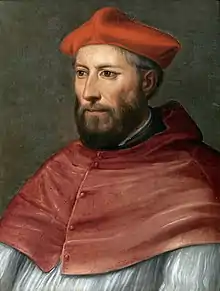
Pietro Accolti (15 March 1455 – 11 December 1532), known as the "cardinal of Ancona", was an Italian Roman Catholic cardinal and judge of the Roman Rota.
Life
He was born in Florence on 15 March 1455, the son of the famous jurist Benedetto Accolti the Elder and his wife Laura Federighi.[1] He studied law at Pisa. In 1481, due to the influence of his uncle, Francesco Accolti, master of law, Pietro was appointed a reader of canon law. He moved to Rome sometime after 1485, and was appointed an auditor of the Roman Rota, that is, a judge who hears cases.[2]
In 1500, he became Dean of the Rota. He was made Bishop of Ancona in 1505, but continued sitting with the Rota. At a consistory on 10 March 1511,Pope Julius II named him Cardinal-Priest with the title of Sant'Eusebio.[3] That same year, he given the administration of the bishoprics of Cadiz and Maillezais. To these were added the dioceses of Arras in 1518, and Ancona in 1523. He also had, as cardinal-bishop, starting from 18 Dec. 1523, the suburbicarian dioceses of Albano (until May 20, 1524),[4] of Palestrina (May 20-June 15, 1524),[5] and, finally, of Sabina (from June 15).[6]
He was abbreviator under Pope Leo X, and in that capacity drew up in 1520 the bull against Martin Luther.[7]
During the 1521–1522 papal conclave that followed the death of Leo, Cardinal Accolti was one of the Papabile who opposed the Emperor, receiving five votes on the first ballot. This prompted a satire on the part of Pietro Aretino, whose patron, Cardinal Giulio de' Medici, was also a contender. Aretino mocked Cardinal Accolti's not always impeccable morals, and the fact that he was rumored to have three illegitimate children. Mazzucchelli says Accolti had a daughter Caterina, who took the veil; a son Hadrian, alive in 1521; and a son Benedetto, supposedly hanged in Rome in 1564,[2] for having taken part in a conspiracy against Pope Pius V. However, the last was more likely the son of his nephew Benedetto.[8]
In 1524 he was made Archbishop of Ravenna (1524) by Pope Clement VII.
Accolti was an active participant in the main political and ecclesiastical events of his era. French chancellor Antoine Duprat, considered Accolti the most cultured and literate member of the college of cardinals.[2] Accolti died on 11 December 1532 in Rome and was buried in the church of Santa Maria del Popolo, without an inscription.[9]
References
- ↑ Ciaconius, Alphonsus (1677). Vitae, et res gestae pontificum Romanorum et s.r.e. cardinalium (in Latin). Vol. Tomus Tertius (3). Rome: Philippus et Antonius de Rubeis (de Rossi). p. 295.
- 1 2 3 "Accolti, Pietro", Treccani
- ↑ Conradus Eubel, Hierarchia catholica III, editio altera (Münster 1923), p. 55.
- ↑ Eubel, p. 55.
- ↑ Eubel, III, p. 57 column 2.
- ↑ Eubel, III, p. 58 column 1.
- ↑ Lorenzo Cardella (1793). Memorie storiche de' cardinali della santa Romana chiesa (in Italian). Vol. Tomo terzo (3). Roma: Pagliarini. p. 350.
- ↑ "Accolti, Pietro", The Biographical Dictionary of the Society for the Diffusion of Useful Knowledge--, Volume 1, Issue 1, Longman, Brown, Green, and Longmans, 1842
 This article incorporates text from this source, which is in the public domain.
This article incorporates text from this source, which is in the public domain. - ↑ Cardella, III, p. 352.
Sources
- W.W. (1842), "Accolti, Pietro," in: The Biographical Dictionary of the Society for the Diffusion of Useful Knowledge. Vol. I. London: Longman, Brown, Green, and Longmans. 1842. pp. 225–226.
- Miranda, Salvador. "ACCOLTI, Pietro (1455-1532)". The Cardinals of the Holy Roman Church. Florida International University. OCLC 53276621.
- Cheney, David M. "Pietro Cardinal de Accolti de Aretio". Catholic-Hierarchy.org. Retrieved December 27, 2019. [self-published]
- Attribution
- This article incorporates text from a publication now in the public domain: Chisholm, Hugh, ed. (1911). "Accolti, Pietro". Encyclopædia Britannica (11th ed.). Cambridge University Press.
External links
- David M. Cheney, Catholic-Hierarchy.org, "Pietro Cardinal de Accolti de Aretio", retrieved: 2017-05-27. [self-published]